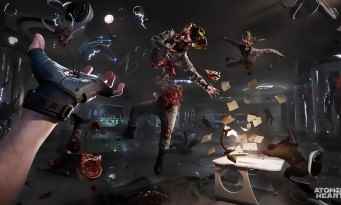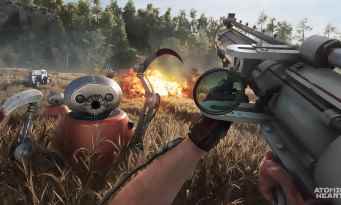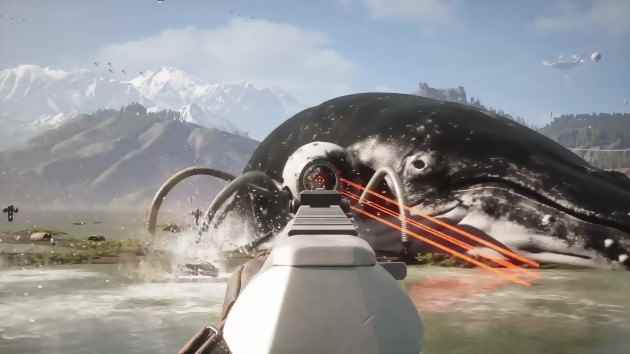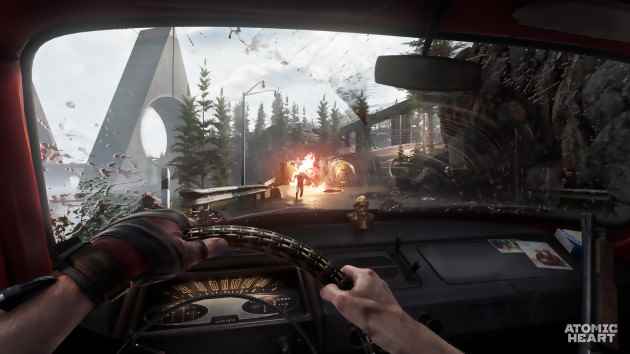A young Russian studio whose first game is Mundfish, it has no less than 130 developers in its ranks. This is at least the number of people who worked on Atomic Heart during the 5 years of development necessary to set up this FPS which is both ambitious, but also endowed with a real artistic vision. It is true however that by putting our hands on the game (4 hours of hands-on on PC), it is difficult not to see the many inspirations borrowed here and there. BioShock, Half-Life, Fallout, Control, or even Arkane productions, the studio did not hesitate to draw on the side of the big names of the First Person Shooter to build its own. If we must recognize a certain patter in Mundfish, a question remains: does Atomic Heart manage to offer a real personality by dint of drawing inspiration from others? Ten minutes to discover the prologue of the game will have been enough to convince us immediately, and to see that it emerges from this Atomic Heart a real visual identity. Probably because the game moves away from the usual codes of Western games where the United States is the center of the world. Here, the story is set in a dystopian Soviet Union of the 1950s, a fictional time when Suchanop’s inventions helped usher in an era of technological prosperity for the Soviet Union. In his laboratory, Suchanop has set up a device that connects humans to robots, with the aim of being able to control machines by thought.
What we saw in the promotional trailers and the final rendering, keyboard / mouse or controller in hand is similar. No downgrade or bullshit graphic rendering, Atomic Heart shines as much by its artistic direction as the finesse and richness of its graphics.
 Of course, like any sci-fi story, nothing goes as planned and these robots with not-so-artificial AIs have turned against their creators. It is moreover in this idyllic setting that Atomic Heart opens, which makes us both enjoy the exhilarating atmosphere of an idyllic Soviet Union (which turned away from the space race to trace way more technologically advanced), but also sublime graphics. The first clash with Atomic Heart is indeed visual. What we saw in the promotional trailers and the final rendering, keyboard / mouse or controller in hand is similar. No downgrade or bullshit graphic rendering, Atomic Heart shines as much by its artistic direction as the finesse and richness of its graphics. The prologue invites the player to indulge in this festive atmosphere where life is good in this alternative “Russia”, with the possibility of interacting with many NPCs. The developers have also put the package from the start, with a city teeming with people, going about their business, talking to each other and also accosting us to offer us to buy technological trinkets or eat ice cream. Certainly, we are still far from the standard of living or the rate of chatter of a Rockstar Games production, but Atomic Heart does not have to be ashamed in the face of the behemoths of the genre made by the Americans.
Of course, like any sci-fi story, nothing goes as planned and these robots with not-so-artificial AIs have turned against their creators. It is moreover in this idyllic setting that Atomic Heart opens, which makes us both enjoy the exhilarating atmosphere of an idyllic Soviet Union (which turned away from the space race to trace way more technologically advanced), but also sublime graphics. The first clash with Atomic Heart is indeed visual. What we saw in the promotional trailers and the final rendering, keyboard / mouse or controller in hand is similar. No downgrade or bullshit graphic rendering, Atomic Heart shines as much by its artistic direction as the finesse and richness of its graphics. The prologue invites the player to indulge in this festive atmosphere where life is good in this alternative “Russia”, with the possibility of interacting with many NPCs. The developers have also put the package from the start, with a city teeming with people, going about their business, talking to each other and also accosting us to offer us to buy technological trinkets or eat ice cream. Certainly, we are still far from the standard of living or the rate of chatter of a Rockstar Games production, but Atomic Heart does not have to be ashamed in the face of the behemoths of the genre made by the Americans.
ATOMIC SHOCK!
Of course, this paradise is only temporary and as Rapture and Columbia have perished in BioShock and BioShock Infinite, prosperity will give way to a nightmare led by the rebellion of the machines. Luckily for the soldier you lead, he’s equipped with technological advancements, including a connected, bionic left arm that can evolve and unleash all manner of energy blasts as he moves. will collect the resources necessary to strengthen itself. This is where our first contact with the game system took place, strongly taken from the games of Ken Levine, with this ambidextrous gameplay with which you have to juggle. Fire or melee weapons in the right hand, powers to trigger with the left, Atomic Heart does not lace and offers monster game possibilities. Our character is even able to dodge attacks on the sides with a speed that is his own, and which will allow him to get out of often complex situations. Because where Atomic Heart also surprised us is in the challenge it offers. Each robot you will meet will give you a hard time, even to the point that the first battles may discourage more than one, unless you are used to the tortures inflicted by FromSoftware productions and their Dark Soul. Because yes, the enemies can one-shot us if we are not careful enough, while the locations of the checkpoints can also surprise. Atomic Heart actually takes up old school mechanics, with care kits to recover to heal, items to recover en masse and save terminals to move forward. There are indeed a few automatic save points, but you will have to take up some old player reflexes so as not to be overwhelmed.
This is where we understand that the melee combat in Atomic Heart is as important as the gunfights, and that certain situations are better resolved in hand-to-hand combat than at a distance.
If Atomic Heart can be sluggish at first, taking the risk of cooling more than one, it’s also to get us used to what happens afterwards. The game developed by Mundfish is not sensitive and you will have to activate your reflexes to avoid dying repeatedly. The enemies will indeed multiply, the difficulty will increase crescendo and you have to be ready to face the hordes of robots who will stop at nothing. Fortunately, our soldier has a sizeable arsenal to face the enemy. Of course, we start light, with in particular an ax which has a light and heavy attack, which already makes it possible to face the first enemies. This is where we understand that the melee combat in Atomic Heart is as important as the gunfights, and that certain situations are better resolved in hand-to-hand combat than at a distance. Very quickly, we will have access to terminals to upgrade our weapons, and make others, provided we recover the original model. A weapon reproduction system reminiscent of The Callisto Protocol and its 3D printer. On the power side, the system is based on the same principle of acquisition, with the possibility of swinging electric shocks, sending waves of polymers to slow down enemies, or downright levitating them to crush them to the ground like an angry Jedi. Where Atomic Heart goes further in this ambidextrous gameplay is that it is possible to combine the two elements, between the powers on one side and its firearms on the other. For example, the polymer that invades the screen and slows the movements of robots can be combined with an electric shot or a fire explosion, since the substance is conductive. Combos that can be multiplied according to the weapons in possession, such as keeping enemies in the air and riddled them with bullets before exploding them on the ground. It’s quite enjoyable, we’re not going to hide it.
I, ROBOT
 Whatever happens, Atomic Heart makes every effort to prepare the player for what happens after 7 hours of corridor play, namely access to the open world of the game. From a certain moment, Atomic Heart passes from the very linear and narrative FPS to an open world with multiple objectives and quests to complete. A very nice surprise for which we were not prepared, but which the developers wanted to show us by propelling us directly into the area. We’re not going to hide it from you, we would have liked to find out for ourselves at the time of the test, but obviously Mundfish was keen to circulate the information, no doubt quite proud to be able to offer such a result, whereas other FPS are still to choose between the two proposals. It is in this open world (which we were able to fly over via a special machine) at the start of the game which makes it possible to better understand the gameplay, and to understand the behavior of the enemies. Because we are in front of robots which attack together, and with strategy, it is also preferable for the player to establish a certain plan of attack and not to rush headlong, under penalty of dying quickly. The robots work together, including surveillance cameras capable of alerting the nearest patrols. They can be land, but also air and that’s where things get complicated, because the enemy is coming from everywhere. Worse, some robots can be repaired in the middle of a fight by other mechanical healers, which means that you don’t have to stay too long to attack an enemy. This is where the use of weapons and powers must be as clever and effective as possible. Another element of the gameplay that exists in Atomic Heart, but that we were unable to test during hands-on, due to lack of time, are the passages of reflection, with a lot of puzzles to overcome. Again, the game uses the neurons of the player, who will have to use the abilities in his possession to unlock a door, activate a lever via the physical skills assigned to him. In short, variety in gameplay and proposals, and for a first game, it’s almost surreal.
Whatever happens, Atomic Heart makes every effort to prepare the player for what happens after 7 hours of corridor play, namely access to the open world of the game. From a certain moment, Atomic Heart passes from the very linear and narrative FPS to an open world with multiple objectives and quests to complete. A very nice surprise for which we were not prepared, but which the developers wanted to show us by propelling us directly into the area. We’re not going to hide it from you, we would have liked to find out for ourselves at the time of the test, but obviously Mundfish was keen to circulate the information, no doubt quite proud to be able to offer such a result, whereas other FPS are still to choose between the two proposals. It is in this open world (which we were able to fly over via a special machine) at the start of the game which makes it possible to better understand the gameplay, and to understand the behavior of the enemies. Because we are in front of robots which attack together, and with strategy, it is also preferable for the player to establish a certain plan of attack and not to rush headlong, under penalty of dying quickly. The robots work together, including surveillance cameras capable of alerting the nearest patrols. They can be land, but also air and that’s where things get complicated, because the enemy is coming from everywhere. Worse, some robots can be repaired in the middle of a fight by other mechanical healers, which means that you don’t have to stay too long to attack an enemy. This is where the use of weapons and powers must be as clever and effective as possible. Another element of the gameplay that exists in Atomic Heart, but that we were unable to test during hands-on, due to lack of time, are the passages of reflection, with a lot of puzzles to overcome. Again, the game uses the neurons of the player, who will have to use the abilities in his possession to unlock a door, activate a lever via the physical skills assigned to him. In short, variety in gameplay and proposals, and for a first game, it’s almost surreal.


